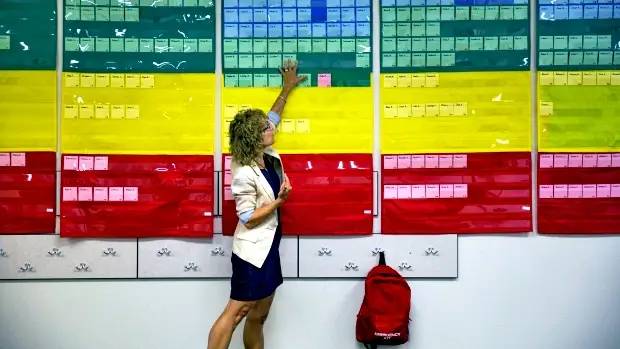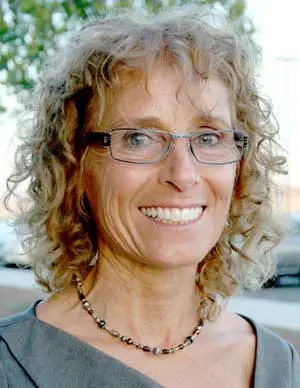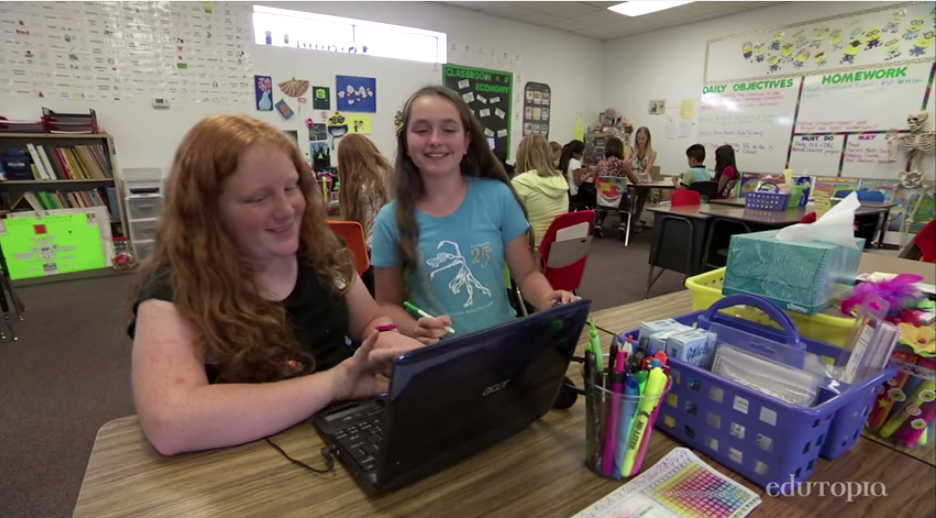When Cole Young, former principal of Humboldt Elementary School, received an email from a nonprofit organization about how highly performing schools overcome challenges, he initially thought it was an ad asking his school to take part in a competitive application process.
It wasn’t, and Humboldt Elementary is one of five schools in the country highlighted in “Schools that Work,” a series created by Edutopia, a web-based resource and online community created by The George Lucas Educational Foundation. The site focuses on identifying and spreading innovative, replicable, evidence-based approaches to helping students learn better.
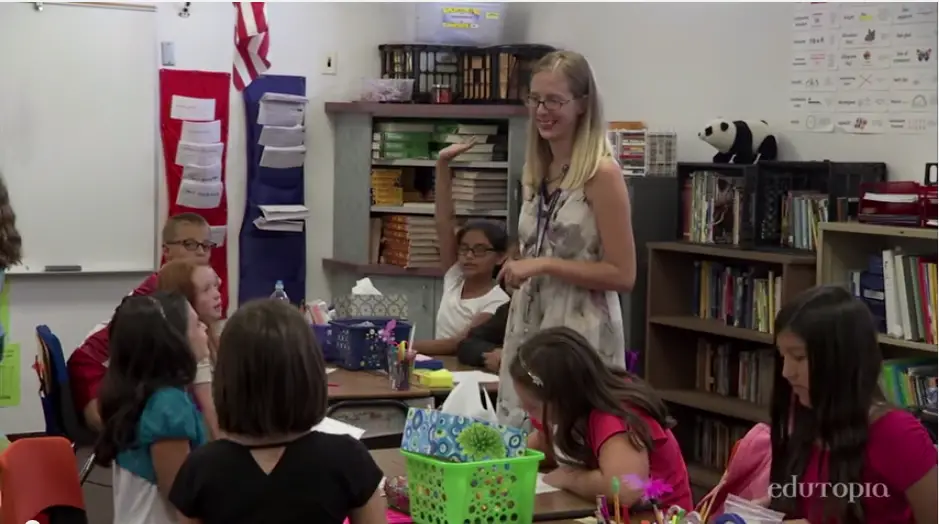
Jamy Myrmel, fifth grade teacher at Humboldt Elementary School working with her students. Photo courtesy Edutopia
Edutopia was interested in how the school with 75 percent of students on free- and reduced-lunch had gone from being close to labelled an underperforming school in 2004 to being named a National Blue Ribbon School in 2010 and a 2013 National Title I Distinguished School for High Performance, said Paul Stanton, superintendent of Humboldt Unified School District in Yavapai County.
When Young spoke with Stanton about the email from Edutopia, Stanton urged him to take part in the opportunity.
“I spoke with school staff concerning the request and was met with a resounding, ‘Let’s do this!’” Young said. “I then found out what an amazing opportunity was about to transpire in the little town of Humboldt.”
How Humboldt Elementary did it
Humboldt Elementary used data and assessments to better target instruction, initiated program to help students meet standards, and creatively re-allocated instructional time at the end of the day with its I Choose program to give fourth- through sixth-grade students extended learning opportunities.
Cole Young, former principal of Humboldt Elementary School. Photo courtesy Sue Tone/Prescott Valley Tribune
“The I Choose program is rooted in the research of Response To Intervention through identifying, diagnosing and developing academic action plans focused on individual learning needs,” Stanton said.
Humboldt Unified has focused on building systems throughout all schools that focus on serving students where they are in their academic development, and provided staff with intensive training in RTI and systems that reward positive behavior over the past three years, Stanton said.
After interviewing school leadership, teachers, an instructional specialist and the Title I reading teacher, Edutopia came to the 450-student K-6 school in a rural town about 15 miles from Prescott to film teachers parents and students for their “Schools that Work” videos.
“Edutopia coming to Humboldt Elementary has given credence to our process of how we, as a district, examine student learning with a laser-like focus through our RTI systems approach,” Stanton said. “Teachers across the district have inherent buy-in to the notion of RTI and its potential effectiveness for kids and their learning.”
Focus on reading
Humboldt Elementary uses several different assessments to measure student achievement in reading, including DIBELS, Galileo and AIMS.
Instructional specialist Gwen Walton’s room has a color-banded row of four hanging pockets that hold colored index cards that each represent a student and their level of performance. Photo courtesy Edutopia
Each student’s results are represented by a colored index card: Blue for students who are above the benchmark, green for students who meet the benchmark, yellow for those performing below the benchmark and red for those performing farthest below the benchmark. Those cards start out on the same color band in a four-color hanging pocket chart.
Every three weeks, students’ progress is assessed and their cards move along the color bands according to their achievement.
“Our grade level meetings allow us time to review student data, look for trends in achievement and give us information on what are our successful instructional practices,” a teacher said.
Then teachers determine what students needs are and create intervention groups and enrichment opportunities to meet them.
Lisa Navarro-Uvila, principal of Humboldt Elementary School
“All of our schools’ data is rooted in the district-wide assessment system,” Stanton said. “This continuity of data helps to calibrate how we, as a district, identify academic needs through a process of rigorous data analysis and reflection.”
Then students are looked at individually and clustered in intervention groups according to common academic need, Stanton said.
“How we service these needs may look a little different at each of our campuses due to their unique circumstances and resources available,” Stanton said.
Humboldt Elementary Principal Lisa Navarro-Uvila said the data-driven reading program has increased parents’ involvement and shows parents what specific skills their children need help with.
“As the parents understand how to read the data (reports), they are able to see if their child is continuing to progress or needs more support,” Navarro-Uvila said.
One parent said the data reports show “you where your child is at, what they need help with, and where they have grown. The school also shows us ways to read with and support our kids reading at home.”
Edutopia Video: Sharing Data to Create Stronger Parent Partnerships
Next, math
The method has worked so well that this year Humboldt Elementary started an in-depth analysis of students’ math assessment data to develop a math intervention program, Navarro-Uvila said.
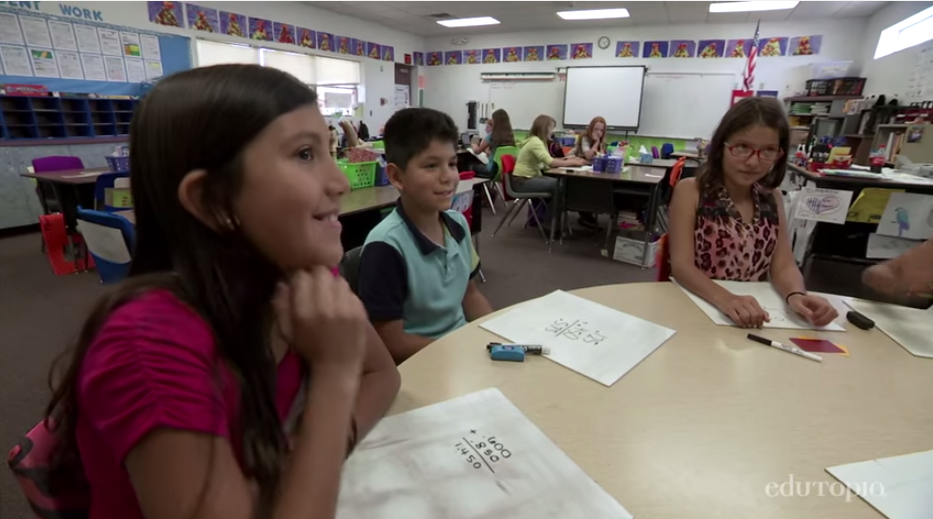
Students working in small groups with a teacher at Humboldt Elementary school during I Choose. Photo courtesy Edutopia
“We began slowly with small group interventions at the classroom level, then moving to a larger school-wide intervention model piloting a couple of different computer-based, leveled, math intervention programs,” Navarro-Uvila said.
Now, educators are analyzing what interventions had the most impact to prepare for the next school year, Navarro-Uvila said.
Making time for small groups, differentiated learning
Then teachers asked administrators for time in the school day to work with students in small groups and provide differentiated instruction to meet students’ needs.
“Teachers know their students better than anyone when it comes to their academic needs,” said Young, who is now the district’s director of educational services. “They know if they can carve out a small portion of the day teaching specific skills to identified students who need them, they will have an immediate academic impact.”
So Young and teachers worked together to create the I Choose program, which provides fourth- through sixth-graders a 30-minute period at the end of the day where they can benefit from intervention when they need it and also choose their preferred activity.
Paul Stanton, superintendent of Humboldt Unified School District
“For those who are struggling, this provides time for them to get the academically-targeted assistance they need,” Young said. “This shift of instructional time to intervention opportunity focuses more on the needs of kids and less about the amount of content being taught.”
Another key was creating smaller groups of students for teachers to work with so their instruction would be more effective, Young said.
When the students who do not need intervention that day leave for I Choose, the teacher works with 15 or fewer students doing small-group or one-on-one work and activities, a teacher said.
While some teachers may use an exit ticket for that day’s lesson to determine who needs to stay for extra help, other teachers may choose a specific group who need help with a specific skill and work with them for several days or even weeks, the teacher said.
“Sometimes the teacher will keep in a high-level group to do some enrichment or get a jump on next year’s concepts,” the teacher said. “One of the benefits of this program is the flexibility to meet the needs of all students while providing the teacher with valuable time to meet with small groups. It takes a whole school to run a program like this successfully.”
Young noted that I-Choose does not take the place of a student’s electives or specials.
“I-Choose is a separate part of the day that offers extended learning opportunities for students to participate in when it comes to music, P.E., library, computer lab, peer tutoring with younger grade levels, etc.” Young said.
Students peer tutoring at Humboldt Elementary School. Photo courtesy of Edutopia
I Choose also keeps students motivated and engaged in class which leads to more completed assignments, better preparation for assessments and boosts attendance, Young said.
One student, who tutored other students during I Choose, said, “It was really fun and I liked it. Sometimes, when we help other students, it helps us to understand the lesson better too.”
The student also appreciated learning in smaller groups.
“When we work in small groups, hearing other people explain the concept in a different way helps you understand,” the student said.
“Every staff member plays a vital role in freeing up time for this intervention opportunity,” Young said. “We are committed to this process because it makes a difference and is best for our kids.”
Parents agree.
“These programs have helped my child grow so much, not only educationally, but in his confidence as well,” a parent said. “He started off as a very timid, not sure of himself student and now he is a very confident, happy child. The difference is amazing.”
Stanton said, “The commitment and dedication of this staff is amazing and it’s just one of our nine schools in the district that continues to do a lot in the area of student learning with very few resources.”
“Edutopia picking Humboldt Elementary School as a school that works resonates through the district with pride and sense of accomplishment for students, staff, and community,” Stanton said.
Edutopia video: Student-Driven Differentiated Instruction with “I Choose”









